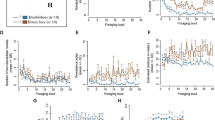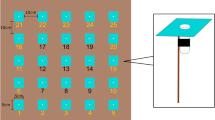Abstract
Honey bees were displaced several 100 m from their hive to an unfamiliar site and provisioned with honey. After feeding, almost two-thirds of the bees flew home to their hive within a 50 min observation time. About half of these returning, bees signalled the direction of the release site in waggle dances thus demonstrating that the dance can be guided entirely by information gathered on a single homeward trip. The likely reason for the bees’ enthusiastic dancing on their initial return from this new site was the highly rewarding honeycomb that they were given there. The attractive nature of the site is confirmed by many of these bees revisiting the site and continuing to forage there.



Similar content being viewed by others
References
Batchelet E (1981) Circular statistics in biology. Academic Press, London
Becker L (1958) Untersuchungen über das Heimfindevermögen der Bienen. Z vergl Physiol 41:1–25
Brines ML (1978) Skylight polarisation patterns as cues for honey bee orientation. Thesis, Rockefeller University, New York
Capaldi EA, Smith AD, Osborne JL, Fahrbach SE, Farris SM, Reynolds DR, Edwards AS, Martin A, Robinson GE, Poppy GM, Riley JR (2000) Ontogeny of orientation flight in the honey bee revealed by harmonic radar. Nature 403:537–540
Collett M, Collett TS (2000) How do insects use path integration for their navigation? Biol Cybern 83:245–259
Collett M, Collett TS, Wehner R (1999) Calibration of vector navigation in desert ants. Curr Biol 9:1034
De Marco R, Menzel R (2005) Encoding spatial information in the waggle dance. J Exp Biol 208:3885–3894
Edrich W (1975) The waggle dance of the honeybee; a new formulation. Fortschr Zool 23:20–30 and 48–51
Edrich W (1977) The interaction of light and gravity in the orientation of the waggle dance of honey bees. Anim Behav 25:342–363
Edrich W, Farina W, Kramer E, Nunez JA (1995) Soliciting behaviour of Africanized honey bees studied in Salta, Argentina. In: Proceedings of the international conference on tropical bees & the environment, 1994. Mardan M, Sipat A, Yusoff, KM, Kiew HMSR, Abdullah MM (eds) Jutaprint, 2 Solok Sungei Pinang 3, 11600 Penang, Malaysia, pp 34–38. The author will send a reprint on request
Esch H, Burns J (1996) Distance estimation by foraging honeybees. J Exp Biol 199:155–162
Lehrer M (1993) Why do bees turn back and look? J Comp Physiol A 172:549–563
Lindauer M (1948) Über die Einwirkung von Duft und Geschmacksstoffen sowie anderen Faktoren auf die Tänze der Bienen. Z vergl Physiol 31:48–412
Mittelstaedt H (1983) The role of multimodal convergence in homing by path integration. Fortschr Zool 28:197–212
Opfinger E (1931) Über die Orientierung der Bienen an der Futterstelle. Z vergl Physiol 15:431–487
Otto F (1959) Die Bedeutung des Rückflugs für die Richtungs- und Entfernungsangabe der Bienen. Z vergl Physiol 42:303–333
Pahl M, Zhu H, Tautz J, Zhang S (2011) Large scale homing in honeybees. PLoS One 65:e19669. doi:10.1371/journal.pone0019669
Romanes GJ (1885) Homing faculty of Hymenoptera. Nature 32:630
Scharstein H (1975) Der Mechanismus der Sollwertverstellung bei der Kursregelung der roten Waldameise. Doctoral thesis: Ludwig-Maximilian Universität München
Seeley TD, Mikheyev AS, Pagano GJ (2000) Dancing bees tune both duration and rate of waggle- run production in relation to nectar-source profitability. J Comp Physiol A 186:813–819
Sklenar G (1954) Imkerpraxis, 7th edn. Weber-Sklenar H Selbstverlag, Mistelbach Zaya, Niederösterreich
Southwick EE, Buchmann SL (1995) Effects of horizon landmarks on homing success in honey bees. Am Nat 146:748–764
Srinivasan MV, Zhang SW, Lehrer M, Collett TS (1996) Honeybee navigation en route to the goal: visual flight control and odometry. J Exp Biol 199:237–244
Tanner DA, Visscher PK (2010) Adaptation or restraint? Reference dependent scatter in honey bee dances. Behav Ecol Sociobiol 64:1081–1086
Tautz J, Zhang S, Spaethe J, Brockmann A, Aung S, Srinivasan MV (2004) Honeybee odometry: performance in varying natural terrain. PloS Biol 2. doi:10.1371.Journal.pbio,20211
Uchida T, Kuwabara M (1951) The homing instinct of the honeybee, Apis mellifica. J Fac Sci Hokkaido Univ 10:87–96
von Frisch K (1965) Tanzsprache und Orientierung der Bienen. Springer, Berlin, Heidelberg
von Frisch K (1967) Dance language and orientation of bees. Belknap Harvard University Press, London
von Helversen O, Edrich W (1974) Der Polarisationsempfänger im Bienenauge: ein Ultraviolettrezeptor. Comp Physiol 94:33–47
Acknowledgments
With this study, the author wishes to remember the late Ernst Kramer. His modesty hid his extra-ordinary creativity. His skills enhanced the work of many, not only biologists, like the author. He invented remarkable devices and also communicated generously his often unorthodox ideas to facilitate worldwide research. As a friend he provided many helpful suggestions not only on ‘bees’. The author is also grateful to many people for their assistance in the experiments. Mrs. Regina Fischer-Gerlach, Werner Friedrich, Astrid Heiling, and Jay McCartney among others, helped in the field. Oskar Pöhlmann and family allowed me to work on their grounds. Horst Mittelstaedt and Tom Collett gave valuable comments and helped to polish the English of this paper and Thomas Decker and Marina Sergejeva did patient proof reading. Tom Collett, Friedrich Barth and the two anonymous reviewers maintained that the presented data and interpretations deserve further dissemination; particular thanks to them. Thomas Reichmann prepared the illustrations. Dietrich Mautz and Egbert Roth of the Bayerische Landesanstalt für Bienenzucht, at those days still in Erlangen, supplied bees, while funds and instruments were provided by the University Erlangen-Nürnberg.
Author information
Authors and Affiliations
Corresponding author
Ethics declarations
Guidelines for the care and use of animals were followed.
Rights and permissions
About this article
Cite this article
Edrich, W. Honey bees can perform accurately directed waggle dances based solely on information from a homeward trip. J Comp Physiol A 201, 1003–1010 (2015). https://doi.org/10.1007/s00359-015-1030-7
Received:
Revised:
Accepted:
Published:
Issue Date:
DOI: https://doi.org/10.1007/s00359-015-1030-7




